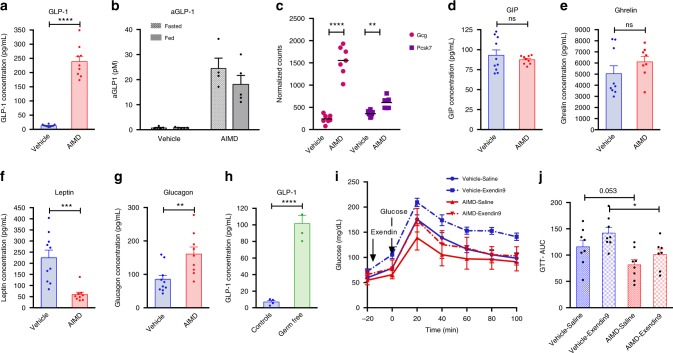Fig. 4.
AIMD increases GLP-1 and affects other gut hormones. a Fasting serum level of total GLP-1 (n = 9–10/group). b Serum level of active GLP-1 after 16 h of fasting (fasted) or 15 min after an oral bolus of glucose (1 g/kg BW; fed). Blood was collected on Ddp4 inhibitor-coated tubes (n = 5/group). c Quantification by RNA-sequencing of Ggc and Pcsk7 mRNA expression in the cecum (n = 7–8/group). Adjusted p value from negative binomial Wald test (corrected for multiple hypothesis testing with the Benjamini–Hochberg method), *p < 0.05, **p < 0.01, ***p < 0.001, ****p < 0.0001. d–g Serum endocrine panel—plasmatic levels of GIP (d), ghrelin (e), leptin (f), and glucagon (g) (n = 9–10/group). h Serum level of total GLP-1 in GF mice (n = 4/group). i, j AIMD or vehicle mice were IP injected Exendin-9 (250 nmol/kg) or saline 20 min prior to receiving an oral bolus of glucose (1 g/kg BW) and glucose concentration was monitored over 100 min (n = 8/group). Quantification of the area under the curve (AUC, j). Serum collection and oGTT were performed at 1 week after intervention. Unless otherwise stated, Student’s t test, *p < 0.05, **p < 0.01, ***p < 0.001, ****p < 0.0001, ns nonsignificant. All error bars are SEM

